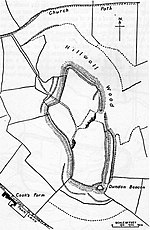Somerton railway station
1906 establishments in England1964 disestablishments in EnglandDisused railway stations in SomersetFormer Great Western Railway stationsPages with no open date in Infobox station ... and 5 more
Railway stations in Great Britain closed in 1964Railway stations in Great Britain opened in 1906Somerton, SomersetUse British English from December 2016Wikipedia page with obscure subdivision
Somerton railway station (not to be confused with Fritwell & Somerton) was a railway station situated on the Great Western Railway's Langport and Castle Cary Railway. It served the town of Somerton in Somerset, England.
Excerpt from the Wikipedia article Somerton railway station (License: CC BY-SA 3.0, Authors).Somerton railway station
Station Path,
Geographical coordinates (GPS) Address Nearby Places Show on map
Geographical coordinates (GPS)
| Latitude | Longitude |
|---|---|
| N 51.052956 ° | E -2.733324 ° |
Address
Somerton
Station Path
TA11 7PX , Somerton
England, United Kingdom
Open on Google Maps








